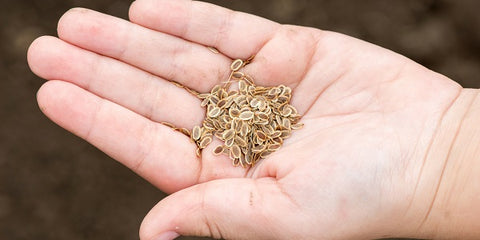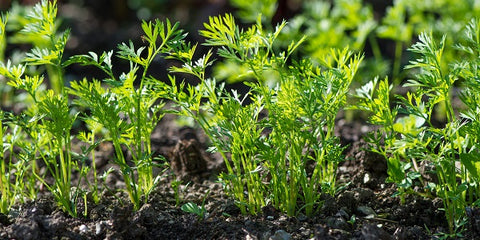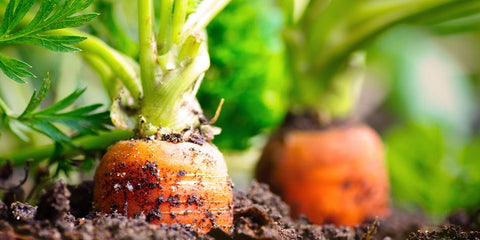Guide to Sowing & Growing Carrots

Growing quality carrots requires evenly moist well drained soil that is deep (at least 20-25cm), loose and free of lumps and stones. Ensure you are not sowing your carrots into soil to which you have recently added fresh manure. It's best to compost it well in advance to give the material time to break down before sowing your carrots - sowing into soil that is too rich will encourage sappy growth and forking of the roots.
Soil temperature can also be critical for germination - at 10 degrees C, seed will germinate in about 10 days; between 10 and 25 degrees, this will shorten to 8 days. Any higher than that, it's getting too hot, and germination rates will start to fall away. Root growth and development is fastest at temperatures between 15 and 20 degrees.

Sow your carrots where they are to grow, as they resent being transplanted - you can then thin them in stages, so they're the correct distance apart.
Sow in drills about 2cm deep and 15cm apart. With this spacing, the foliage of adjacent plants will make a dense canopy when the plants are mature.
Sow the seeds sparingly on top, then cover with about 0.5cm of soil. Try to space them 1cm apart.
Carrot seeds are tiny - try mixing them with sand to make sowing easier, or sow a mixture of carrot and radish seed. The radish will germinate quickly and will mark the rows until the carrots come up. And you can pick and eat the radishes before they get in the way of the carrots.

Carrots must be kept moist to germinate. Heavy rains after sowing may compact the soil surface, making it more difficult for the seedlings to emerge. Covering the row with a plank after sowing seeds may help to prevent this, and will also improve germination in dry weather, as it will help to retain soil moisture. Carrot seed doesn't need light to germinate. Check frequently and remove the plank when the seeds have germinated. Mulching will help hold the moisture, will make it easier to water without disturbing the seeds, and will help to keep any exposed carrot shoulders from turning green.

To prevent diseases like Alternaria and Cercospora fungal blights, which can reduce yield and quality, make sure you're not growing carrots in the same spot more often than once every three years. At the first sign of lesions on the leaf margins or if the leaves start to shrivel, give them a spray with a fungicide like Copper to control the spread.
Carrot fly and wireworms can be a problem in some gardens, using fertile well broken in ground and crop rotation will limit these as will fabric row covers to limit adult insect laying eggs in your crop.
To harvest your carrots, pull them up when the roots are at least 1cm in diameter. You may need to loosen the soil around the carrot to allow them to be pulled up - the carrot tops may not be strong enough to actually be pulled from the ground, and it is a shame if your carrots are left behind!
Carrot Types
Ball type:
These are ideally suited to container growing in large shallow pots as they can grow on the surface - an example is Carrot Paris Market, which is also popular with chefs as a very attractive gourmet carrot.
Berlicum type:
A berlicum carrot is straight with a blunt end and will grow to about 20cm long. In our range you could choose Amsterdam Sprint, Berlicum or Samantha F1.
Nantes type:
A Nantes (pronounced "Nonce") carrot is straight with a pointed end, and is slightly longer than a Berlicum carrot, growing to about 25cm long. In our range we have Tendersweet, Scarlet Nantes or Touchon. Touchon is well regarded for sowing in the autumn months
Kuroda type:
The Kuroda carrot is suitable for growing in the higher temperatures of summer or in tropical areas and is thick and tapered. In our range we offer Kuroda Improved.
Flakkee type:
These carrots grow very large and are a great stock fodder or used for juicing as a sweet healthy vegetable drink. You'll find Carrot Giant Flakkee in the Field Selection.
Imperator type:
These carrots grow long and straight and are therefore good processing carrots. Some imperator type carrots in our range are Purple Dragon and Rainbow Blend.
Carrots have been grown in a rainbow of colours for several thousand years, but the original ones were purple and white. Dutch breeders, paying homage to their Royal family - the House of Orange - were responsible for breeding and promoting the orange carrot in the 1600s and 1700s.

They were so successful in doing so that orange carrots are now considered the standard and the other colours are "gourmet" and "unusual".






















































